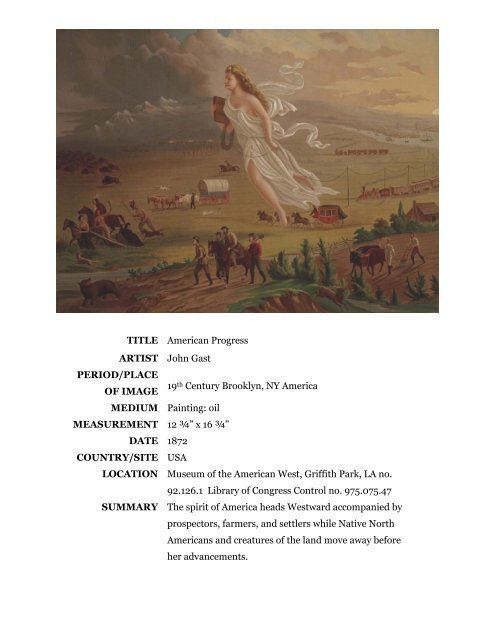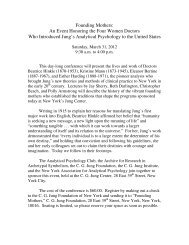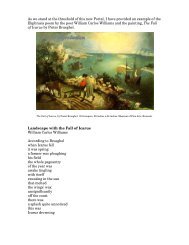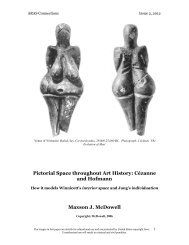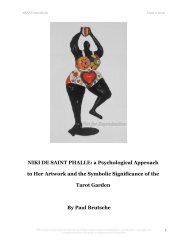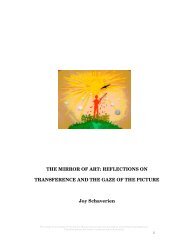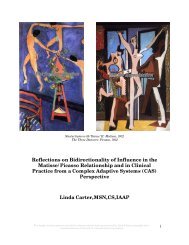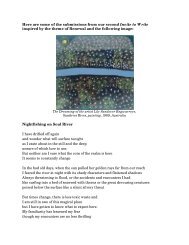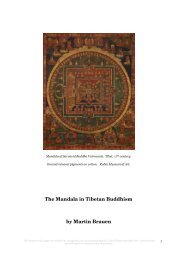American Progress by John Gast - ARAS
American Progress by John Gast - ARAS
American Progress by John Gast - ARAS
Create successful ePaper yourself
Turn your PDF publications into a flip-book with our unique Google optimized e-Paper software.
PERIOD/PLACE<br />
TITLE <strong>American</strong> <strong>Progress</strong><br />
ARTIST <strong>John</strong> <strong>Gast</strong><br />
OF IMAGE 19th Century Brooklyn, NY America<br />
MEDIUM Painting: oil<br />
MEASUREMENT 12 ¾” x 16 ¾”<br />
DATE 1872<br />
COUNTRY/SITE USA<br />
LOCATION Museum of the <strong>American</strong> West, Griffith Park, LA no.<br />
92.126.1 Library of Congress Control no. 975.075.47<br />
SUMMARY The spirit of America heads Westward accompanied <strong>by</strong><br />
prospectors, farmers, and settlers while Native North<br />
<strong>American</strong>s and creatures of the land move away before<br />
her advancements.
DESCRIPTION<br />
A large, luminous, ethereal, feminine figure of “<strong>American</strong> <strong>Progress</strong>” with the<br />
“star of the empire” on her forehead and long, light, wavy hair leads miners,<br />
settlers, and travelers from East to West. As she advances, she suspends<br />
telephone cable. She holds the excess wire in her right hand where she also<br />
carries a schoolbook. With her progression, the darkness fades as she ushers in<br />
new light. Men of various trades accompany her on foot and <strong>by</strong> various methods<br />
of transportation: horseback, covered wagon, carriage, steam engine, and ships.<br />
The Mississippi river flows in the background in the upper right quadrant. In the<br />
lower right, farmers cultivate the land and there is a stone house with a boundary<br />
marked <strong>by</strong> trees and a split-rail fence. Three men in the central bottom portion<br />
walk next to a rider. One man carries a lowered shotgun at the ready and<br />
another, wearing a red shirt and smoking a pipe, props a miner’s shovel on his<br />
right shoulder.<br />
In the left of the image, beneath the peaks of snow-topped mountains, wild<br />
bison and a bear retreat into the darkness into which the water of a river also<br />
flows. Several Native <strong>American</strong>s look back as they move accompanied <strong>by</strong> dogs<br />
towards the darkness at the left. A bare-chested male raises a tomahawk and<br />
another carries a bow and arrow. A horse draws a travois carrying a mother and<br />
a child and another woman walks as a member of the Native tribe, bare-breasted<br />
and looking over her left shoulder.<br />
CULTURAL CONTEXT<br />
George Crofutt, publisher of a fashionable western travel guide series,
commissioned the creation of “<strong>American</strong> <strong>Progress</strong>” <strong>by</strong> the Brooklyn resident,<br />
painter, and lithographer, <strong>John</strong> <strong>Gast</strong>. Crofutt reproduced the petite painting,<br />
done in 1872, as a color lithograph poster and also engraved the image in the<br />
guidebooks he published widely circulating the image. The painting depicts a<br />
sense of technological development’s advancement upon the untamed land like<br />
the coming of an impenetrable, inevitable militia with one uncharacteristic<br />
exception--the company is led <strong>by</strong> a feminine figure.<br />
In the wake of four years of Civil War, the creation of the promotional<br />
material of “<strong>American</strong> <strong>Progress</strong>” portrays a spiritualized feminine that provides<br />
nurturing, protective guidance and fortitude for the extension of civilization over<br />
wilderness and the “uncivilized,” the enigmatic, and the primal. Disembodied,<br />
the idealized feminine portrays the evolution of the split of spirit from daily life as<br />
well as the sanctified superiority of the immigrants above human beings who<br />
lived in harmony with the spirit of the land.<br />
The dominating and centralized angelic being’s paradoxical innocence and<br />
sensually alluring presence has the effect of distracting and softening the reality<br />
and the violence of this movement to “win the west” where Native <strong>American</strong>s<br />
depart the frame as non- natives stake claims in the form of prospectors, as<br />
settlers: farmers, homesteaders, and travelers. One of the popular artists of the<br />
times, Maynard Dixon speaks of the untruth of the romanticized representation<br />
of facts as he complained he was being paid to lie in his artwork and portrayals of<br />
life on the wild prairie (Dixon).<br />
Fueled <strong>by</strong> an underlying desire to be free from tyrannical government and<br />
the prospect of a new life and livelihood in a world new to them, Euro-<strong>American</strong>s
manifested suffering and persecution similar to the very situation they sought to<br />
escape.<br />
CULTURAL COMPLEX<br />
“<strong>American</strong> <strong>Progress</strong>” is bound to the concept of “Manifest Destiny” first<br />
found in print under the authorship of newspaper editor <strong>John</strong> O’Sullivan in 1845<br />
who claimed America had been chosen to carry out the task of expansionism to<br />
drive out the wilderness and bring the light of civilization upon the continent.<br />
This concept defined the rapid expansion in the 1800s of the New World from<br />
East to West and continues to be an influential, <strong>American</strong> way of thinking.<br />
America’s westward expansion and colonization included territorial acquisition<br />
and, though not initially part of government policy, eventually influenced the<br />
passage of future legislation, such as the Homestead Act.<br />
What is “accepted” in the complex?<br />
The idea of progress coming from the East to the West, and the<br />
notion that the frontier would be developed <strong>by</strong> sequential waves<br />
of people (here [...] always men) was deeply rooted in <strong>American</strong><br />
thought. (Sandweiss)<br />
<strong>Gast</strong>’s painting of progress refers to modernization, to the concept of<br />
advancement and improvement in areas: technological, social, political,<br />
economic, scientific, and personal. An influential marketing piece and symbol of<br />
the times, the story the painting tells equates progress with achievement,<br />
development, mechanization, speed, distance, and expansion; with acquisition<br />
and possession in a civilization dependent upon technology and with a social
order that values striving, conquering, staking claims, and establishing<br />
ownership. Euro-<strong>American</strong> men were actively, heroically participating in what<br />
they saw as a God-granted right, a historical destiny they were helping to<br />
manifest, as they moved forward across the plains towards the Rockies and<br />
beyond. The painting conveys the idea that what comes from the right side or<br />
rational logos has power and direct connection to the light or what is enlightened.<br />
In the image, the dominant intention presents itself as a movement of the right or<br />
consciousness to illumine the darkness of the left. The dominant intention also<br />
presents itself as a movement forwards and upwards away from harmony with<br />
the earth. Transportation bellows forward in the whistles and mechanized<br />
poundings of the transcontinental railroad and communication moves upwards<br />
strung on poles above ground level. Even the particular model of education and<br />
thinking evidences itself as elevated, as heightened, carried as a book in the arms<br />
of the angelic being. The veneration of the book devalues Nature’s inherent<br />
wisdom and generosity. What silently evidences itself is an attitude of<br />
entitlement, privilege, and superiority of one race over and above another, of<br />
power that includes power over another. This separation includes the division of<br />
spirit from earthly life and from matter and places it in the realm above.<br />
What is rejected in the complex?<br />
In viewing the peripheral areas in the left side of “<strong>American</strong> <strong>Progress</strong>,” the<br />
details reveal the devaluation and rejection of what is simple, wild, mysterious,<br />
and dark asserting a need to tame what is wild, viewing what is wild as “other,”<br />
what is not understood as savage. The dark, creative potential of the feminine
that understands what Carl Gustav Jung called the lumen naturae or the light in<br />
nature is demonized. The image shows the natural world of the frontier and its<br />
inhabitants as something to be conquered and tamed. Human beings and<br />
animals indigenous to the land are being driven out to make way for animals that<br />
were in service to man. “Uncultured” people living close with the earth, with<br />
matter and the Great Spirit are displaced to make room for the structure of<br />
progress.<br />
ARCHETYPAL CONTEXT<br />
The image of “<strong>American</strong> <strong>Progress</strong>” advances a virginal, domestic, yet<br />
indomitable feminine presence distanced from her connection with the earth<br />
while validating the take over of <strong>American</strong> wilderness.<br />
“It is the benign domestic influence of our allegorical figure, [...]<br />
<strong>Gast</strong> seems to indicate, that is responsible for the smooth and<br />
uplifting transformation of wilderness into civilization”<br />
(Greenberg 2).<br />
The image as a whole promotes a myth of separation as progress relates to the<br />
Apollonic and Athenian conceptualizations of a civilization based on a more<br />
masculine principle intending to define, harness, and tame life, set in opposition,<br />
rather than integrated with the indigenous understanding of life’s<br />
interconnectivity, mystery, and magic.<br />
In the painting, right and left, heaven above and earth below, are divided<br />
into positive, powerful, superior, conscious, spiritual light and negative, weak,<br />
unconscious, undeveloped, primal darkness. The idea portrays a polarization of a<br />
transcendent divinity and the purely material world thus removing the sacred
from daily life and establishing a hierarchical system sustained <strong>by</strong> a hunger for<br />
achievement as well as promises of materialism. Coupled with this greed was a<br />
sense of entitlement in the exploitation of the de-spiritualized earth and her<br />
inhabitants.<br />
The feminine figure and focus of <strong>Gast</strong>’s 1872-commissioned painting recalls<br />
the classical folds of another famous feminine figure’s garments and her message<br />
of liberty. Two years before the completion of <strong>Gast</strong>’s “<strong>American</strong> <strong>Progress</strong>,” the<br />
first small model of the benevolent grace of Liberty Island’s welcoming Statue of<br />
Liberty Enlightening the World was created. A widely recognized symbol, the<br />
lady of the New York Harbor indicated a successful journey for immigrants and<br />
visitors the world over. Viktor Frank, in his book Man’s Search for Meaning,<br />
proposed the need on the shores of the Pacific coast, for a Statue of<br />
Responsibility to balance the liberty of the Atlantic coast and remind people that<br />
freedom requires a maturity that includes responsibility. The statue of two joined<br />
hands each reaching across and cradling the wrist of the other is to be completed<br />
in July of 2010. The sculpture intends to express an empowered connection of all<br />
human beings and to serve as an inspiration that crosses the imposed boundaries<br />
of difference and celebrates the potential within human beings and conscious<br />
interaction with life’s diverse presence.<br />
In the spirit of renewing some indigenous wisdom, Chief Seattle in 1845<br />
shared how human beings are only strands in the web of life and asks of those<br />
who come to lay claim to the earth:<br />
[...] this land is sacred to us. How can you buy or sell the sky, the<br />
rain, and the wind? That idea is strange to us. If we do not own<br />
the freshness of the air and the sparkle of the water, how can you
uy them? Every part of this earth is sacred to my people. Every<br />
sandy shore, shining pine needle, every mist in the dark woods,<br />
every clearing and humming insect is holy in the memory and<br />
experience of my people. I know the sap that courses through the<br />
trees as I know the blood that flows in my own veins. [...] We are<br />
part of the earth and it is part of us.<br />
The indigenous people foresaw the occurrences and the immanent shift of<br />
progress in America through dreams and visions. The transition of life for<br />
human beings led to the development and integration of modern conveniences in<br />
the way people reside with the land. Houses built with foundations now come<br />
equipped with heat and electricity and clean running water; with stoves for<br />
cooking and refrigerators for keeping food fresh and edible for a longer period of<br />
time. Transportation, such as planes and automobiles, allows people and goods<br />
to travel great distances in a short amount of time providing further<br />
conveniences. Readily available food from grocery stores and restaurants graces<br />
the tables of people across the nation without the need for each family to take on<br />
the labor involved in tilling soil and planting and tending crops or animals.<br />
Farmers have equipment that assists in their work.<br />
Scientific advancements have taken the imaginations of human beings into<br />
the heavens and given an altered perspective of the solar system and the planet<br />
earth in her splendor. Satellites and fiber-optic cable transmit information<br />
globally. Communication advancements in telephones and cell phones and the<br />
Internet mean human beings can connect with loved ones or work on projects<br />
together even when they are at great physical distances from one another.<br />
Researching information has become much simpler as has accessing local and
global news and weather. Educational programs, videos and books, music and<br />
artwork are all readily available with a computer and an Internet connection.<br />
<strong>Progress</strong> is being made in the ways human beings work with one another and also<br />
with energy having transitioned from mainly burning coal and wood to utilizing<br />
petroleum products and electricity, and now exploring nuclear as well as<br />
alternative possibilities with water, wind, and solar power.<br />
Medical advancements have altered the infant mortality rate, eradicated<br />
smallpox, diminished the instances of polio and diphtheria, and raised the<br />
average life expectancy. In 1840, life expectancy at birth ranged from the late<br />
twenties to around forty years of age. Individuals now live to be in their eighties<br />
and nineties and some even into the hundreds.<br />
<strong>Progress</strong> socially reveals its bounty where freedom of thought and freedom<br />
of opinion are heralded as basic human rights in a culture moving towards a<br />
celebration of diversity in a unity with a return to an understanding of the<br />
oneness of life.<br />
QUESTIONS RAISED<br />
What does progress serve? What role and responsibility do human beings<br />
have in what is being made manifest? Is the true destiny of America being lived?<br />
What needs to be reclaimed?<br />
PHOTO SOURCE<br />
Central Pacific Railroad Photographic History Museum 5 May 2010. 3 Oct. 2002.<br />
.
BIBLIOGRAPHY<br />
Dixon, Maynard. Art and Spirit. Narrated <strong>by</strong> Diane Keaton. Prod. and dir. Jayne<br />
McKay. Cloud World. 2007.<br />
Greenberg, Amy S. Manifest Manhood and the Antebellum <strong>American</strong> Empire.<br />
Cambridge UP. 15 May 2010.<br />
.<br />
O’Sullivan, <strong>John</strong>. “<strong>John</strong> O’Sullivan Coins the Phrase ‘Manifest Destiny’ 1845.” 7<br />
May 2010. Excerpted from “Annexation,” The United States Magazine and<br />
Democratic Review 17 Jul. 1845: 5––10. 18 Jul. 2004. .<br />
Sandweiss, Martha A. <strong>John</strong> <strong>Gast</strong>, <strong>American</strong> <strong>Progress</strong>, 1872. 27 Apr. 2010.<br />
Amherst College<br />
.<br />
“Statute of Responsibility.” Exec. Prod. Daniel L. Bolz. Prod. and Dir. <strong>John</strong> Farr.<br />
24 May 2010. CMG, 2005.<br />
.<br />
Seattle, Chief. “Chief Seattle’s Reply.” 24 May 2010. Nar. Wes Felty. .


